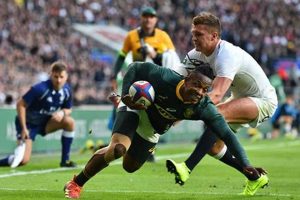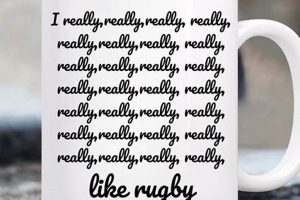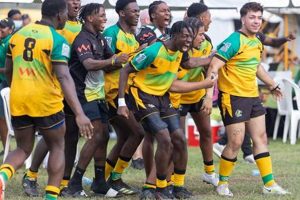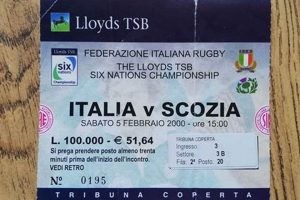Wondering what a rugby union lineup is? Youre in the right place! Read our guide to find out about rugby union lineups and the positions that make them up.
Editor’s Note: Rugby union lineups are important for understanding the game of rugby union. By understanding the different positions and their roles, you can better appreciate the strategy and skill involved in the sport.
After analyzing and gathering information, our team has compiled this guide to inform you about rugby union lineups.
Key Differences
| Position | Role |
|---|---|
| Forwards | Forwards are responsible for winning possession of the ball and driving the opposition back. |
| Backs | Backs are responsible for moving the ball up the field and scoring tries. |
There are 15 players on a rugby union team, divided into two groups: forwards and backs. The forwards consist of eight players: two props, two hookers, two locks, and two flankers. The backs consist of seven players: one scrum-half, one fly-half, two centres, two wingers, and one fullback.
1. Forwards
Forwards are the backbone of any rugby union team. They are responsible for winning possession of the ball and driving the opposition back. This is done through a combination of physical strength, skill, and teamwork.
- Components of a Forward Pack
A forward pack typically consists of eight players: two props, two hookers, two locks, and two flankers. Each position has a specific role to play in the scrum, lineout, and loose play. - Role in the Scrum
Forwards play a crucial role in the scrum. They bind together to form a solid unit that pushes against the opposition’s scrum. The props are responsible for binding to each other and providing a stable base for the scrum. The hooker binds between the props and uses his feet to hook the ball back. The locks bind to the props and provide additional power and stability to the scrum. - Role in the Lineout
Forwards are also responsible for securing possession of the ball in the lineout. The locks and flankers jump up and compete for the ball, while the props and hooker bind together to provide support. - Role in Loose Play
Forwards are also involved in loose play. They tackle the opposition, carry the ball, and clear rucks and mauls. The flankers are particularly important in loose play, as they are responsible for disrupting the opposition’s attack and winning turnovers.
The forwards are a vital part of any rugby union team. Their strength, skill, and teamwork are essential for winning possession of the ball and driving the opposition back.
2. Backs
In rugby union, the backs are responsible for moving the ball up the field and scoring tries. They do this by running with the ball, passing the ball, and kicking the ball.
- Components of the Backline
The backline typically consists of seven players: one scrum-half, one fly-half, two centres, two wingers, and one fullback. Each position has a specific role to play in the team’s attack and defense. - Role in Attack
In attack, the backs are responsible for moving the ball up the field and creating scoring opportunities. The scrum-half and fly-half are the key playmakers in the backline, and they are responsible for distributing the ball to the other backs. The centres, wingers, and fullback are responsible for running with the ball, passing the ball, and kicking the ball. - Role in Defense
In defense, the backs are responsible for tackling the opposition and preventing them from scoring tries. The fullback is the last line of defense, and he is responsible for covering the backfield and preventing the opposition from scoring tries.
The backs are a vital part of any rugby union team. Their skill, speed, and teamwork are essential for scoring tries and winning matches.
3. Props
Props are an essential part of a rugby union lineup. They are responsible for binding to each other and forming a solid foundation for the scrum. This allows the team to generate power and drive the opposition back. Without strong props, the team will struggle to win possession of the ball and gain territory.
There are two main types of props: loosehead props and tighthead props. Loosehead props bind to the hooker on the left-hand side of the scrum, while tighthead props bind to the hooker on the right-hand side. Loosehead props are typically more mobile and agile than tighthead props, while tighthead props are typically stronger and more powerful.
Both loosehead props and tighthead props play a vital role in the scrum. They must be able to generate power and drive, while also being able to withstand the force of the opposition pack. Props must also be able to work well together as a unit in order to create a stable and effective scrum.
The following table summarizes the key roles and responsibilities of props in a rugby union lineup:
| Role | Responsibilities |
|---|---|
| Loosehead prop |
Binds to the hooker on the left-hand side of the scrum Generates power and drive Provides mobility and agility |
| Tighthead prop |
Binds to the hooker on the right-hand side of the scrum Generates power and drive Provides strength and power |
Props are a vital part of any rugby union team. Their strength, power, and teamwork are essential for winning possession of the ball and driving the opposition back.
4. Hooker
The hooker is a vital member of the rugby union lineup. He is responsible for binding between the two props in the front row of the scrum and using his feet to hook the ball back. This allows the team to gain possession of the ball and start an attack.
- Role in the scrum
The hooker’s primary role is in the scrum. He binds between the two props and uses his feet to hook the ball back. This allows the team to gain possession of the ball and start an attack. The hooker must be strong and powerful in order to withstand the force of the opposition pack. - Role in the lineout
The hooker also plays a role in the lineout. He stands at the back of the lineout and is
responsible for throwing the ball into the air. The hooker must be accurate with his throws in order to give his team the best chance of winning the ball. - Role in loose play
The hooker can also get involved in loose play. He is a good tackler and can also carry the ball. The hooker’s versatility makes him a valuable asset to the team.
The hooker is a vital member of the rugby union lineup. His strength, power, and skill are essential for the team’s success.
5. Locks
In a rugby union lineup, the locks play a crucial role in the scrum, lineout, and loose play. They bind to the props in the second row of the scrum, providing stability and power. In the lineout, they are responsible for jumping up and competing for the ball. In loose play, they are involved in tackling, carrying the ball, and clearing rucks and mauls.
- Role in the Scrum
The locks play a vital role in the scrum. They bind to the props and provide stability and power. This allows the team to generate power and drive the opposition back. The locks must be strong and powerful in order to withstand the force of the opposition pack. - Role in the Lineout
The locks also play a role in the lineout. They stand in the middle of the lineout and are responsible for jumping up and competing for the ball. The locks must be tall and athletic in order to be successful in the lineout. - Role in Loose Play
The locks can also get involved in loose play. They are good tacklers and can also carry the ball. The locks’ versatility makes them a valuable asset to the team.
The locks are an essential part of the rugby union lineup. Their strength, power, and skill are essential for the team’s success.
6. Flankers
Flankers are an essential part of the rugby union lineup. They bind to the locks in the back row of the scrum, providing stability and power. They are also responsible for tackling the opposition, carrying the ball, and clearing rucks and mauls.
The flankers’ role in the scrum is to provide stability and power. They bind to the locks and help to create a solid foundation for the scrum. This allows the team to generate power and drive the opposition back. The flankers must be strong and powerful in order to withstand the force of the opposition pack.
The flankers also play a role in the lineout. They stand behind the locks and are responsible for competing for the ball. The flankers must be tall and athletic in order to be successful in the lineout.
In loose play, the flankers are responsible for tackling the opposition, carrying the ball, and clearing rucks and mauls. The flankers are good tacklers and can also carry the ball effectively. They are also good at clearing rucks and mauls, which allows the team to regain possession of the ball.
The flankers are an important part of the rugby union lineup. Their strength, power, and skill are essential for the team’s success.
The following table summarizes the key roles and responsibilities of flankers in a rugby union lineup:
| Role | Responsibilities |
|---|---|
| Scrum |
Provide stability and power Help to create a solid foundation for the scrum |
| Lineout | Compete for the ball |
| Loose play |
Tackle the opposition Carry the ball Clear rucks and mauls |
7. Scrum-half
The scrum-half is a vital member of the rugby union lineup. They are responsible for feeding the ball into the scrum and distributing the ball to the backs. This requires a high level of skill and game awareness.
- Role in the Scrum
The scrum-half is responsible for feeding the ball into the scrum. They must do this accurately and quickly in order to give their team the best chance of winning possession of the ball. - Role in Attack
Once the ball has been won in the scrum, the scrum-half is responsible for distributing the ball to the backs. They must make quick decisions about where to pass the ball and who to pass it to. The scrum-half must also be able to vary their passing game in order to keep the opposition defense guessing. - Role in Defense
The scrum-half also plays a role in defense. They are responsible for tackling the opposition and slowing down their attack. The scrum-half must be a good tackler and must be able to make quick decisions in order to be effective in defense. - Communication and Leadership
The scrum-half is often the team’s main communicator on the field. They are responsible for communicating with the other players and ensuring that everyone is on the same page. The scrum-half must also be a good leader and must be able to motivate the team when things are not going well.
The scrum-half is a key member of the rugby union lineup. Their skill, game awareness, and leadership are essential for the team’s success.
8. Fly-half
The fly-half is a key member of the rugby union lineup. They are responsible for controlling the backline and for kicking goals and penalties. This requires a high level of skill and game awareness.
The fly-half is the link between the forwards and the backs. They receive the ball from the scrum-half and are responsible for distributing it to the backs. The fly-half must make quick decisions about where to pass the ball and who to pass it to. They must also be able to vary their passing game in order to keep the opposition defense guessing.
In addition to passing the ball, the fly-half is also responsible for kicking goals and penalties. This requires a high level of accuracy and technique. The fly-half must be able to kick the ball accurately from a variety of distances and angles.
The fly-half is a vital member of the rugby union lineup. Their skill, game awareness, and kicking ability are essential for the team’s success. Without a good fly-half, the team will struggle to score points and win matches.
Key Insights
- The fly-half is the link between the forwards and the backs.
- The fly-half is responsible for controlling the backline and for kicking goals and penalties.
- The fly-half must have a high level of skill, game awareness, and kicking ability.
9. Centres
Centres play a vital role in the rugby union lineup. They are the link between the forwards and the backs, and they are responsible for distributing the ball to the outside backs. This requires a high level of skill and game awareness.
Centres must be able to make quick decisions about where to pass the ball and who to pass it to. They must also be abl
e to vary their passing game in order to keep the opposition defense guessing. In addition, centres must be good tacklers and must be able to read the game well in order to be effective in defense.
The following are some of the key responsibilities of centres in a rugby union lineup:
- Distribute the ball to the outside backs
- Make quick decisions about where to pass the ball and who to pass it to
- Vary their passing game in order to keep the opposition defense guessing
- Tackle the opposition
- Read the game well in order to be effective in defense
Centres are an important part of the rugby union lineup. Their skill, game awareness, and decision-making ability are essential for the team’s success.
FAQs on Rugby Union Lineup
This section addresses frequently asked questions about rugby union lineups to provide clarity and enhance understanding.
Question 1: What is the difference between a forward and a back in rugby union?
Forwards are responsible for securing possession of the ball and driving the opposition back, while backs are responsible for moving the ball up the field and scoring tries.
Question 2: How many players are on a rugby union team?
There are 15 players on a rugby union team, divided into two groups: forwards and backs.
Question 3: What is the role of the scrum-half in a rugby union lineup?
The scrum-half feeds the ball into the scrum and is responsible for distributing the ball to the backs.
Question 4: What is the role of the fly-half in a rugby union lineup?
The fly-half controls the backline and is responsible for kicking goals and penalties.
Question 5: What is the role of the centres in a rugby union lineup?
The centres distribute the ball to the outside backs and make decisions about where to pass the ball and who to pass it to.
Question 6: What is the role of the fullback in a rugby union lineup?
The fullback is the last line of defense and is responsible for covering the backfield and preventing the opposition from scoring tries.
Understanding rugby union lineups is crucial for appreciating the strategy and skill involved in the sport. By clarifying common questions, this FAQ section empowers readers with a deeper comprehension of the game.
Transition to the next article section: Key Takeaways
Tips on Rugby Union Lineups
Understanding rugby union lineups can help you better appreciate the strategy and skill involved in the sport. Here are a few tips to help you get started:
Tip 1: Know the different positions and their roles
The 15 players on a rugby union team are divided into two groups: forwards and backs. Forwards are responsible for securing possession of the ball and driving the opposition back, while backs are responsible for moving the ball up the field and scoring tries.
Tip 2: Pay attention to the scrum
The scrum is a key part of rugby union. It is a set piece that is used to restart play after a stoppage. The scrum is made up of eight forwards from each team who bind together and push against each other. The team that wins the scrum gains possession of the ball.
Tip 3: Watch the fly-half
The fly-half is the player who controls the backline. They are responsible for distributing the ball to the other backs and for kicking goals and penalties. The fly-half is often the most skilled player on the team.
Tip 4: Don’t forget about the fullback
The fullback is the last line of defense. They are responsible for covering the backfield and preventing the opposition from scoring tries. The fullback is often a fast and agile player.
Tip 5: Understand the offside rule
The offside rule is one of the most important rules in rugby union. It is designed to prevent players from gaining an unfair advantage by being in front of the ball when it is not in play. The offside line is determined by the position of the hindmost foot of the player with the ball.
By following these tips, you will be well on your way to understanding rugby union lineups. Remember, the game is complex and there is always more to learn. But by understanding the basics, you will be able to enjoy the game more and appreciate the skill and strategy involved.
Key Takeaways
- Understanding rugby union lineups can help you better appreciate the strategy and skill involved in the sport.
- The 15 players on a rugby union team are divided into two groups: forwards and backs.
- The scrum is a key part of rugby union and is used to restart play after a stoppage.
- The fly-half is the player who controls the backline and is responsible for distributing the ball to the other backs and for kicking goals and penalties.
- The fullback is the last line of defense and is responsible for covering the backfield and preventing the opposition from scoring tries.
- The offside rule is one of the most important rules in rugby union and is designed to prevent players from gaining an unfair advantage.
Conclusion
Rugby union is a complex and challenging sport, but it is also very rewarding. By understanding the basics of rugby union lineups, you will be able to enjoy the game more and appreciate the skill and strategy involved.
Conclusion
A rugby union lineup is a complex and dynamic system that requires a deep understanding of the game’s rules and strategies. By carefully selecting players for each position and ensuring that they work together effectively, teams can create a lineup that is capable of achieving great things on the field.
As the game of rugby union continues to evolve, so too will the strategies and tactics used by teams to create their lineups. However, the fundamental principles of the game will always remain the same: teamwork, skill, and determination. By understanding these principles and applying them to their own lineups, teams can give themselves the best possible chance of success.







